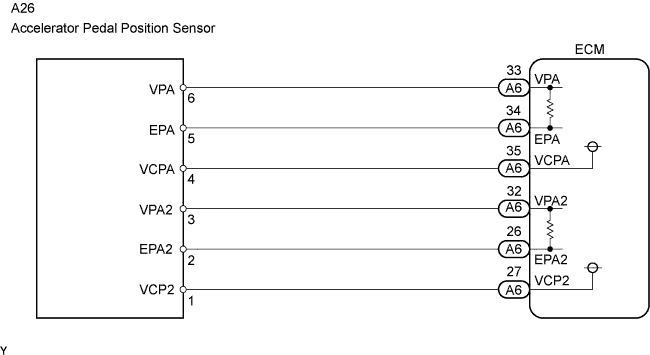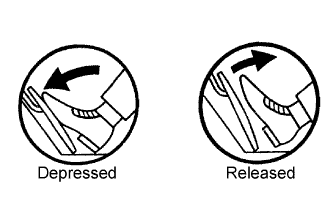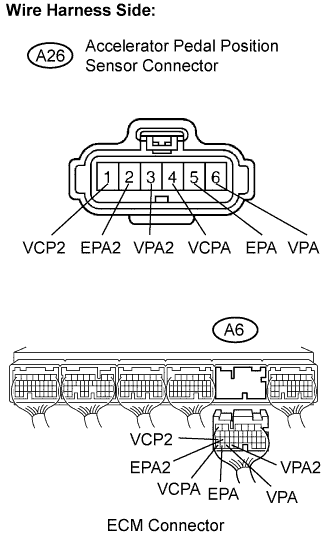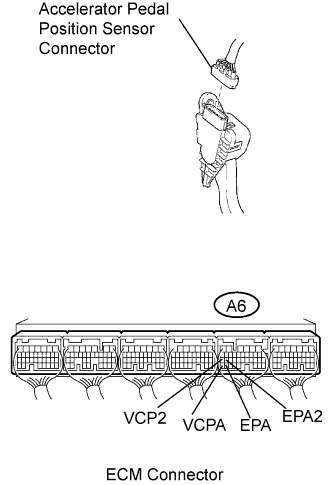READ VALUE OF INTELLIGENT TESTER (ACCEL POS #1 AND ACCEL POS #2)
CHECK HARNESS AND CONNECTOR (ACCELERATOR PEDAL POSITION SENSOR - ECM)
INSPECT ECM (VCPA AND VCP2 VOLTAGE)
REPLACE ACCELERATOR PEDAL ROD ASSEMBLY
CHECK WHETHER DTC OUTPUT RECURS (ACCELERATOR PEDAL POSITION SENSOR DTCS)
DTC P2120 Throttle / Pedal Position Sensor / Switch "D" Circuit |
DTC P2122 Throttle / Pedal Position Sensor / Switch "D" Circuit Low Input |
DTC P2123 Throttle / Pedal Position Sensor / Switch "D" Circuit High Input |
DTC P2125 Throttle / Pedal Position Sensor / Switch "E" Circuit |
DTC P2127 Throttle / Pedal Position Sensor / Switch "E" Circuit Low Input |
DTC P2128 Throttle / Pedal Position Sensor / Switch "E" Circuit High Input |
DTC P2138 Throttle / Pedal Position Sensor / Switch "D" / "E" Voltage Correlation |
DESCRIPTION
This ETCS (Electronic Throttle Control System) does not use a throttle cable.The Accelerator Pedal Position (APP) sensor is mounted on the accelerator pedal bracket and has 2 sensor circuits: VPA (main) and VPA2 (sub). This sensor is a non-contact type, and uses Hall-effect elements, in order to yield accurate signals, even in extreme driving conditions, such as at high speeds as well as very low speeds. The voltage, which is applied to terminals VPA and VPA2 of the ECM, varies between 0 V and 5 V in proportion to the operating angle of the accelerator pedal (throttle valve). A signal from VPA indicates the actual accelerator pedal opening angle (throttle valve opening angle) and is used for engine control. A signal from VPA2 conveys the status of the VPA circuit and is used to check the APP sensor itself.
The ECM monitors the actual accelerator pedal opening angle (throttle valve opening angle) through the signals from VPA and VPA2, and controls the throttle actuator according to these signals.

| DTC No. | DTC Detection Condition | Trouble Area |
| P2120 | VPA fluctuates rapidly beyond upper and lower malfunction thresholds for 0.5 seconds or more (1 trip detection logic) |
|
| P2122 | VPA 0.4 V or less for 0.5 seconds or more when accelerator pedal fully released (1 trip detection logic) |
|
| P2123 | VPA 4.8 V or more for 2.0 seconds or more (1 trip detection logic) |
|
| P2125 | VPA2 fluctuates rapidly beyond upper and lower malfunction thresholds for 0.5 seconds or more (1 trip detection logic) |
|
| P2127 | VPA2 1.2 V or less for 0.5 seconds or more when accelerator pedal fully released (1 trip detection logic) |
|
| P2128 | Conditions (a) and (b) continue for 2.0 seconds or more (1 trip detection logic): (a) VPA2 4.8 V or more (b) VPA between 0.4 V and 3.45 V |
|
| P2138 | Condition (a) or (b) continues for 2.0 seconds or more (1 trip detection logic): (a) Difference between VPA and VPA2 0.02 V or less (b) VPA 0.4 V or less and VPA2 1.2 V or less |
|
- HINT:
- When any of these DTCs are set, check the APP sensor voltage by entering the following menus on the intelligent tester: Powertrain / Engine / Data List / Accelerator Position No. 1 and Accelerator Position No. 2.
| Trouble Areas | ACCEL POS #1 When AP Released | ACCEL POS #2 When AP Released | ACCEL POS #1 When AP Depressed | ACCEL POS #2 When AP Depressed |
| VCP circuit open | 0 to 0.4 V | 0 to 1.2 V | 0 to 0.4 V | 0 to 1.2 V |
| Open or ground short in VPA circuit | 0 to 0.4 V | 1.2 to 2.0 V | 0 to 0.4 V | 3.4 to 5.0 V |
| Open or ground short in VPA2 circuit | 0.5 to 1.1 V | 0 to 0.2 V | 2.6 to 4.5 V | 0 to 0.2 V |
| EPA circuit open | 4.5 to 5.0 V | 4.5 to 5.0 V | 4.5 to 5.0 V | 4.5 to 5.0 V |
| Normal condition | 0.5 to 1.1 V | 1.2 to 2.0 V | 2.6 to 4.5 V | 3.4 to 5.0 V |
- HINT:
- Accelerator pedal positions are expressed as voltages.
- AP denotes for Accelerator Pedal.
FAIL-SAFE
When any of DTCs P2120, P2121, P2122, P2123, P2125, P2127, P2128 and P2138 are set, the ECM enters fail-safe mode. If either of the 2 sensor circuits malfunctions, the ECM uses the remaining circuit to calculate the accelerator pedal position to allow the vehicle to continue driving. If both of the circuits malfunction, the ECM regards the accelerator pedal as being released. As a result, the throttle valve is closed and the engine idles.Fail-safe mode continues until a pass condition is detected, and the engine switch is then turned to off.
WIRING DIAGRAM

INSPECTION PROCEDURE
- HINT:
- Read freeze frame data using the intelligent tester. Freeze frame data records the engine conditions when malfunctions are detected. When troubleshooting, freeze frame data can help determine if the vehicle was moving or stationary, if the engine was warmed up or not, if the air-fuel ratio was lean or rich, and other data, from the time the malfunction occurred (Click here).
- These DTCs relate to the Accelerator Pedal Position (APP) sensor.
| 1.READ VALUE OF INTELLIGENT TESTER (ACCEL POS #1 AND ACCEL POS #2) |
Connect the intelligent tester to the DLC3.
 |
Turn the engine switch on (IG) and turn the tester ON.
Enter the following menus: Power train / Engine / Data List / Accelerator Position No. 1 and Accelerator Position No. 2.
Read the value displayed on the tester.
- Standard voltage:
Accelerator Pedal Operations ACCEL POS #1
(AP#1)ACCEL POS #2
(AP#2)Released 0.5 to 1.1 V 1.2 to 2.0 V Depressed 2.6 to 4.5 V 3.4 to 5.0 V
|
| ||||
| NG | |
| 2.CHECK HARNESS AND CONNECTOR (ACCELERATOR PEDAL POSITION SENSOR - ECM) |
 |
Disconnect the A26 Accelerator Pedal Position (APP) sensor connector.
Disconnect the A6 ECM connector.
Measure the resistance of the wire harness side connector.
- Standard resistance (Check for open):
Tester Connection Specified Condition VPA (A26-6) - VPA (A6-33) Below 1 Ω EPA (A26-5) - EPA (A6-34) Below 1 Ω VCPA (A26-4) - VCPA (A6-35) Below 1 Ω VPA2 (A26-3) - VPA2 (A6-32) Below 1 Ω EPA2 (A26-2) - EPA2 (A6-26) Below 1 Ω VCP2 (A26-1) - VCP2 (A6-27) Below 1 Ω
- Standard resistance (Check for short):
Tester Connection Specified Condition VPA (A26-6) or VPA (A6-33) - body ground 10 kΩ or higher EPA (A26-5) or EPA (A6-34) - body ground 10 kΩ or higher VCPA (A26-4) or VCPA (A6-35) - body ground 10 kΩ or higher VPA2 (A26-3) or VPA2 (A6-32) - body ground 10 kΩ or higher EPA2 (A26-2) or EPA2 (A6-26) - body ground 10 kΩ or higher VCP2 (A26-1) or VCP2 (A6-27) - body ground 10 kΩ or higher
Reconnect the APP sensor connector.
Reconnect the ECM connector.
|
| ||||
| OK | |
| 3.INSPECT ECM (VCPA AND VCP2 VOLTAGE) |
Disconnect the A26 APP sensor connector.
 |
Turn the engine switch on (IG).
Measure the voltage of the A6 ECM connector.
- Standard voltage:
Tester Connection Specified Condition VCPA (A6-35) - EPA (A6-34) 4.5 to 5.0 V VCP2 (A6-27) - EPA2 (A6-26) 4.5 to 5.0 V
Reconnect the APP sensor connector.
|
| ||||
| OK | |
| 4.REPLACE ACCELERATOR PEDAL ROD ASSEMBLY |
| NEXT | |
| 5.CHECK WHETHER DTC OUTPUT RECURS (ACCELERATOR PEDAL POSITION SENSOR DTCS) |
Connect the intelligent tester to the DLC3.
Turn the engine switch on (IG) and turn the tester ON.
Clear DTCs (Click here).
Start the engine.
Allow the engine to idle for 15 seconds.
Enter the following menus: Power train / Engine / DTC.
Read DTCs.
- Result:
Display (DTC Output) Proceed to P2120, P2122, P2123, P2125, P2127, P2128, and/or P2138 A No output B
|
| ||||
| A | ||
| ||